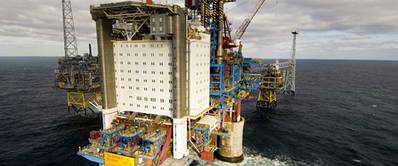The Sleipner A Platform Turns 15
On August 24, one of the world’s most profiled platforms turned 15. Sleipner, also known as the carbon dioxide (CO2) platform, does not look its age.
Sleipner had a tough start. The construction of the first installation became one of the most dramatic in Norwegian oil history.
Shortly before the deck and the concrete substructure for the Sleipner A platform were to be connected, the substructure sank to 200 metres depth in the Gands fiord.
With good assistance from Norwegian Contractors, which constructed a new substructure in record time, Sleipner was able to start its gas deliveries at the agreed time.
Since then, the gas has flowed steadily all the way to Zeebrugge and , while the condensate stream has been sent to Kårstø.
During the last years, Sleipner has strengthened its position as the second largest gas machine in the next to the Troll field.
Sleipner stands out as a modern and robust gas hub thanks to frequent upgradings, tie-ins of other fields such as Sigyn and Volve and the connection to the Troll and Ormen Lange fields.
The field plays a significant role in ensuring reliable gas deliveries to the continent and the .
Production from Sleipner is no longer on plateau, but the field still delivers around 10 percent of StatoilHydro’s total equity production
In the 1990ies the Sleipner field became world-famous for applying technology separating CO2 from the gas stream and reinjecting it into the seabed.
The gas is injected into the gigantic Utsira formation, 1000 metres below the seabed. This year, Sleipner passed 10 million tonnes of reinjected CO2.
The pioneering work of carbon capture and storage has attracted much attention worldwide.
Los Angeles Times has had Sleipner on their front page and National Geographic, BBC and Time Magazine have used Sleipner as an example to be followed in the effort of reducing the greenhouse gas effect.
”Sleipner has a positive and enthusiastic crew both onshore and offshore,” says vice president of operations Sjur B Talstad. “The size of the field and the complex facility provide many challenging and interesting tasks, which are the main reasons why people enjoy working here.”
Sleipner’s equity production comes from the Sleipner East and Sleipner West fields, but Sleipner is a versatile horse and innovative solutions are currently being sought for infrastructure and reception of CO2 from onshore facilities.
“Our own gas production is declining, but as a gas hub with many discoveries in the vicinity, it could be economically wise to use Sleipner’s robust facility and good capacity also in the future. We can also use the carbon experiences to process and inject carbon dioxide from other discoveries in the area. Our production permit was earlier this year extended to 2029, and we are therefore working intensely to find good solutions for the future,” says Mr Talstad.















